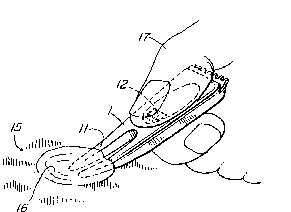Une partie des informations de ce site Web a été fournie par des sources externes. Le gouvernement du Canada n'assume aucune responsabilité concernant la précision, l'actualité ou la fiabilité des informations fournies par les sources externes. Les utilisateurs qui désirent employer cette information devraient consulter directement la source des informations. Le contenu fourni par les sources externes n'est pas assujetti aux exigences sur les langues officielles, la protection des renseignements personnels et l'accessibilité.
L'apparition de différences dans le texte et l'image des Revendications et de l'Abrégé dépend du moment auquel le document est publié. Les textes des Revendications et de l'Abrégé sont affichés :
| (12) Demande de brevet: | (11) CA 2067090 |
|---|---|
| (54) Titre français: | OUTIL POUR REPARER LE GAZON ET NETTOYER LES RAINURES DES BATONS DE GOLF |
| (54) Titre anglais: | GOLF CLUB GROOVE CLEANER AND TURF REPAIR TOOL |
| Statut: | Réputée abandonnée et au-delà du délai pour le rétablissement - en attente de la réponse à l’avis de communication rejetée |
| (51) Classification internationale des brevets (CIB): |
|
|---|---|
| (72) Inventeurs : |
|
| (73) Titulaires : |
|
| (71) Demandeurs : |
|
| (74) Agent: | |
| (74) Co-agent: | |
| (45) Délivré: | |
| (22) Date de dépôt: | 1992-04-24 |
| (41) Mise à la disponibilité du public: | 1992-10-25 |
| Requête d'examen: | 1992-04-24 |
| Licence disponible: | S.O. |
| Cédé au domaine public: | S.O. |
| (25) Langue des documents déposés: | Anglais |
| Traité de coopération en matière de brevets (PCT): | Non |
|---|
| (30) Données de priorité de la demande: | ||||||
|---|---|---|---|---|---|---|
|
ABSTRACT OF THE DISCLOSURE
The invention provides a small, inexpensive cleaning device
that is particularly made to clean the grooves in the face of
most golf clubs heads, both irons and drivers. The object of
these grooves is to give the ball direction and backspin. If
these grooves become clogged the player no longer gets the
proper backspin on the golf ball and loses directional
accuracy. The device has at one end a series of small evenly
spaced fixed teeth, each reinforcing ribs to minimize the
risk of the teeth breaking while the device is being used to
clean the golf club head. The device can be twisted with
respect to the golf club head to enable the cleaning of a
variety of evenly spaced parallel grooves. Additionally, the
device has a pair of large sharp prongs on its opposite end,
which can be used to clean golf shoes and to repair divots
and golf ball marks in the turf on golf course greens. The
prongs have a bend that can be used in conjunction with the
edge of a ball mark depression on the golf green as a fulcrum
to leverage the turf back to a level shape. A thumb grip
concavity is equipped with tread lines to prevent the user's
hand from slipping onto the teeth when the prongs of the
device are being used to repair turf.
Note : Les revendications sont présentées dans la langue officielle dans laquelle elles ont été soumises.
Note : Les descriptions sont présentées dans la langue officielle dans laquelle elles ont été soumises.

2024-08-01 : Dans le cadre de la transition vers les Brevets de nouvelle génération (BNG), la base de données sur les brevets canadiens (BDBC) contient désormais un Historique d'événement plus détaillé, qui reproduit le Journal des événements de notre nouvelle solution interne.
Veuillez noter que les événements débutant par « Inactive : » se réfèrent à des événements qui ne sont plus utilisés dans notre nouvelle solution interne.
Pour une meilleure compréhension de l'état de la demande ou brevet qui figure sur cette page, la rubrique Mise en garde , et les descriptions de Brevet , Historique d'événement , Taxes périodiques et Historique des paiements devraient être consultées.
| Description | Date |
|---|---|
| Inactive : CIB expirée | 2018-01-01 |
| Inactive : CIB désactivée | 2016-01-16 |
| Inactive : CIB en 1re position | 2015-12-11 |
| Inactive : CIB attribuée | 2015-12-11 |
| Inactive : CIB attribuée | 2015-12-11 |
| Inactive : CIB attribuée | 2015-12-11 |
| Inactive : CIB expirée | 2015-01-01 |
| Inactive : Inventeur supprimé | 2002-05-15 |
| Le délai pour l'annulation est expiré | 1994-10-24 |
| Demande non rétablie avant l'échéance | 1994-10-24 |
| Inactive : Demande ad hoc documentée | 1994-04-25 |
| Réputée abandonnée - omission de répondre à un avis sur les taxes pour le maintien en état | 1994-04-25 |
| Demande publiée (accessible au public) | 1992-10-25 |
| Exigences pour une requête d'examen - jugée conforme | 1992-04-24 |
| Toutes les exigences pour l'examen - jugée conforme | 1992-04-24 |
| Date d'abandonnement | Raison | Date de rétablissement |
|---|---|---|
| 1994-04-25 |
Les titulaires actuels et antérieures au dossier sont affichés en ordre alphabétique.
| Titulaires actuels au dossier |
|---|
| HOWARD HAUGOM |
| Titulaires antérieures au dossier |
|---|
| S.O. |